April 30, 2023 – Volume 25, Issue 4
In This Issue
- Flanigan’s Eco-Logic: Rocky Mountain Institute Alumni
- Single-Use Battery Disposal
- Renewables Topping Coal
- Offshore Wind and Fish Farming
- Free Public Transportation in Luxembourg
- Parking Lot Solar
- Six Flags Magic Mountain Goes Solar Big Time
- Flanigan’s Ego-Logic Podcast Updates
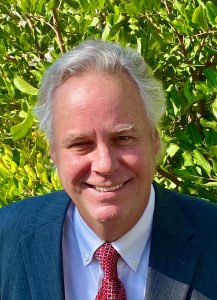
Flanigan’s Eco-Logic: Rocky Mountain Institute Alumni
A thrill it was to be invited and more so to attend an alumni gathering of the Rocky Mountain Institute. Two weeks ago, the event was in Denver. I was drawn to go and I am glad that I did. We alum marveled at the growth of RMI, what it has become. And there’s clearly a potent team at RMI assembled to amplify its innovation, policy work, and implementation.
RMI now has a staff of 648. The Institute has an alumni of 1,700+ that each played a part in the Institute’s rise. I was among the first 20 staff and was RMI’s first Energy Program Director. Like each and every alum, RMI’s founder and our mentor Amory Lovins, fueled my environmental passion with a mission, to be efficient and logical. RMI launched my career.
From the Curtis Hotel lobby on arrival, there was excitement in the air. People checking in, a little bustle of last-minute preparations from staff. Lots of peering at name tags indeed. My plus one was daughter Skye. Right away we ran into Joel Swisher and his wife coming out of the elevators. He’s currently teaching with Amory at Stanford. I see a name tag – Jon Creyts – and make a point before things get too busy to meet RMI’s new CEO. We make a warm connection.
Cocktail reception, gorgeous evening on the hotel’s second floor deck in downtown Denver. All doors are wide open between the ballroom and the deck. Taco, pasta, and some other southwestern bars. Perfect temp. A pleasure to see and reconnect with Michael Shepard. He thought the reception might be a gathering of some 20 – 30 people. No, this was… a banger! In the 600+ range! What a great mix of current and former employees. There were lots of hugs and raised glasses; infinite photos… all there relishing in RMI’s impact and diaspora.
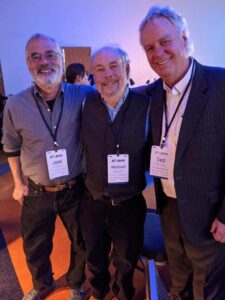
It was fun to witness connections of RMI staff from different offices. Not zoom, but in the flesh! A man with grey beard and pony tail comes up and peers intently. It takes me a minute to realize that it’s original Energy Program team member Joel Neymark. He’s still modeling energy flows. We talk about that, our families, and music. Another familiar face: Kyle Datta and I catch up. He’s based in Hawaii and consults for Southern California Edison on renewables integration.
The music stops, the cocktail gang is encouraged to get dinner and to move into the ballroom. The presentations begin with the Institute’s founder, Amory Lovins, perched on a director’s chair on a small stage. He’s interviewed. “Did you ever – in your wildest dreams – imagine that the Institute would become what it has become?” No, was the gist of that answer.
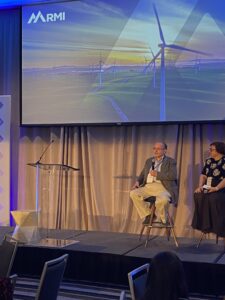
Super witty; super humble. Those in the room all know well that Amory has guided RMI with a brilliant and simple and compelling vision… and a way of thinking. That night Amory talked about applied hope; he talked about the superpowers within us, and unlocking those superpowers. The ability to ask the tough questions, to challenge the status quo.
The reception marked the changing of the guard at RMI: CEO Jules Kortenhorst has stepped down as the CEO after a ten-year term. Under his leadership, RMI’s budget increased 20-fold and its staff grew to over 600 in offices across the United States, and in Beijing. Jules was eloquent in his salute about the Institute’s success being built upon the backs of the RMI staff and alumni.
Then it was his turn for some recognition. RMI’s long standing counsel Marty Pickett announced that an official from the Netherlands Consulate in San Francisco was here to make some comments. But much more than that. He was there to give Jules the hugely distinct “medal of honor” equivalent that the King of the Netherlands had bestowed upon him.
Sitting behind Jules and his family I witnessed deep family joy. I was moved by the site of his son, just beaming, actually bursting with pride. For minutes and with deep connection, he was holding and excitedly rubbing his dad’s shoulder, barely able to contain himself. When his dad rose to accept the award, the medal pinned to his chest, the family stood tall cheering, clapping, thrilled, overjoyed.
Jon Creyts has now taken the mantle. He’s RMI’s new CEO and welcomed all to the event. Prior to becoming CEO, he helped establish RMI’s China program and Beijing office. Before RMI he worked in McKinsey’s global energy practice for 11 years. Jon was also wonderfully kind and deliberate and sincere in thanking the alumni, “We stand upon your shoulders.”
All alumni present certainly felt just as I did. Appreciated. It’s a testament to Jon and the current RMI management. They recognize the team effort that led to the crystallization of an institute originally perched high in the Rocky Mountains of Colorado. The Institute grew. Guided by Amory’s vision, strong leaders, and an exceptional staff, RMI is leading the charge of the clean energy transition.
Later in the week, and in the mountains where it all began, daughters Sierra, Skye, and I hosted a reunion of RMI staff that live in the Roaring Fork Valley. Six of us worked in “the banana farm,” the original RMI headquarters that featured a huge, tropical greenhouse complete with iguanas. Present were Bartlett, Sardo, Rick Heede, Pat Kiernan, Kinsley, and myself.

Kinsley and I shared the Denver experience with our fellow alum, the RMI Alumni experience. We are all deeply satisfied by having played a part in the Institute’s development. Amory’s vision, and a lot of help, led to the small engine that could, to be perhaps the most influential energy organization in the world.

Quote of the Month
“To question is the hard part. If you ask the right design question, the answer is self-evident.”
Single-Use Battery Disposal
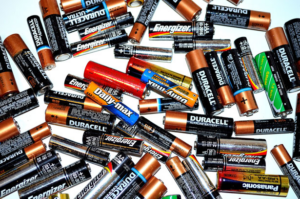
Puzzled I am. How can we be responsible Earth citizens when it comes to single-use battery disposal? I am reminded of my friend Rob Watson who noted in a Flanigan’s Eco-Logic Podcast that there are literally thousands of recycling programs in America confusing us all. What’s a good citizen to do? Can I recycle my batteries? Where do I take them?
Back East several weeks ago, Mom wanted to get rid of some old, household batteries, so I called the Town of Oyster Bay Solid Waste Disposal Center. Where can I take them? I know that batteries are made of all sorts of nasty materials. “Just throw them in the trash,” quipped a friendly and accented operator. “Really? Household batteries?” Yes. “Just throw them in the trash to be landfilled.” But I’d seen batteries in the Town’s own flier of hazardous waste materials.
The operator was busy but willing to field a couple more questions: “How about spent compact fluorescent lamps?” Same thing, “Throw them in the trash.” Really? When I asked about a tractor battery we had in our pile – same size as a typical 12 volt car battery – I was told to take it to hazardous waste disposal. Where’s that? Bethpage. That’s a hike, an adventure. How many people make that kind of trip? Hah… I will take our household batteries there too. Which we did.
So what’s the deal on properly disposing of your typical household batteries? I’ve learned that it depends on what kind of battery that you want to pitch and where you are. In most jurisdictions, common everyday alkaline batteries including AAs, Ds, 9 volts and others are deemed safe for trash. “Ordinary single-use alkaline and carbon-zinc batteries are considered non-hazardous and safe to place in the trash.” But, “All other non-rechargeable batteries, including lithium single-use batteries, as well as button cell watch batteries, contain hazardous heavy metals and toxic chemicals and cannot be disposed of in ordinary trash….”
Alkaline is a battery type developed in Canada in the 1950s in which the electrolyte – usually potassium hydroxide – has a pH value above 7. They derive energy from a reaction between either zinc metal and manganese dioxide, nickel and cadmium, or nickel and hydrogen.
Compared with zinc-carbon batteries or zinc-chloride batteries, alkaline batteries have a higher power density and longer shelf life. As such, today they account for more than 80% of all batteries manufactured each year in the U.S. These are the batteries throughout our homes that power our gadgets: flashlights, toys, remote controls, and smoke alarms.
According to the California Department of Resources Recycling, about 4 billion disposable batteries get shipped to the U.S. every year. A majority of them end up in landfills where they rust and decay over time. Alkaline batteries contain zinc and manganese dioxide which are known neurotoxins. But experts claim that, “compared to other battery types, the toxicity of alkaline batteries is moderate.” Battery makers were required to reduce the amount of mercury in alkaline batteries in 1996. Since then, alkaline batteries are considered by many jurisdictions to be “relatively non-hazardous” materials. Safe or not? That’s where jurisdictions disagree.
Most U.S. states and jurisdictions across the country allow alkaline batteries to be tossed directly into the trash to be landfilled. OMG, the Town of Oyster Bay is hardly alone. But the U.S. EPA recommends the opposite, that alkaline batteries be sent to battery recyclers. It does couch its literature… stating that consumers best “check with your local or state solid waste authority.”
California considers all batteries toxic. Different batteries contain a variety of metals like mercury, lead, cadmium, nickel, and silver which can pose health threats. They also contain “critical minerals” that are deemed strategically important to our country, minerals such as cobalt, lithium, and graphite. In the European Union, alkaline batteries are not allowed to be disposed of in the domestic waste stream. Most stores that sell batteries there are required to take them back to be properly recycled.
Vermont has a statewide alkaline battery collection program. In some states, big-box retailers like Home Depot, Best Buy, Target and WalMart offer recycling programs and e-waste drop off for customer convenience. In the recycling process, the metals from crushed alkaline batteries are mechanically separated, zinc, manganese dioxide, and potassium hydroxide.
Consider me a purist, and without scientific basis for saying so, but I support California’s position on household batteries. While the toxicity of alkaline batteries today may well be far less than it was some years ago, it stands to reason that keeping even trace amounts of toxins out of our waste streams, and properly recycling batteries, makes sense.
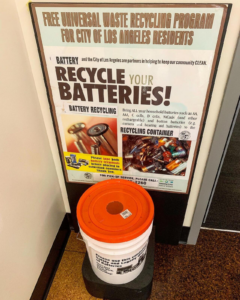
So yes, in some places you can landfill some batteries. On Long Island you can. But others counter and I concur that, “Just because you can, doesn’t mean that you should.” Factual challenges most welcome. I’ll let the Town of Oyster Bay summarize my position:
“Improperly disposing of products such as waste oil, oven cleaner, paint thinner, spot remover or photo chemicals may contaminate your own water supply. Long Island depends upon an underground aquifer system for its water supply. Anything put on the ground or put in cesspools, storm drains, or recharge system can work its way down in the aquifer and our harbors and bays.”
Renewables Topping Coal

Hard to believe it, but take it from a solid source, the U.S. Energy Information Administration. Its latest Monthly Energy Review, with data through February 2023, shows that solar and wind produced more energy than coal in the first two months of 2023. Solar and wind produced 16.1% of the nation’s electricity generation (MWh), while coal dropped 37% from the same period last year, to 16.0%.
Solar, including small-scale distributed systems, grew by 6.7% compared to the same period last year, faster than any other source. EIA reports that much of the solar growth was the result of a 23.6% gain in small-scale, solar rooftop systems which account for 32.5% of the nation’s total solar production. Overall, solar now provides 3.9% of the nation’s output. Wind increased by 6.6% and now provides 12.2% of the nation’s power supply.
When factoring in all renewables, including biomass, geothermal, and hydropower, renewables account for nearly a quarter of the nation’s electricity, 24.1%… outpacing coal by 50.8%. Renewables also outpaced nuclear by 21.9%.
In terms of capacity (MW), renewables now account for 27.6% of the nation’s nameplate capacity, with wind at 11.5% and solar at 6.6%. Combined wind and solar capacity stands at 18.1%, versus coal at 17.1%.
Offshore Wind and Fish Farming

Image Courtesy of MingYang Smart Energy
For years it’s been apparent that there will be conflict between the fishing industry and offshore wind. Now there seems to be a synergy in the making. Mingyang Smart Energy is China’s largest private wind turbine maker. It is now making an offshore wind turbine foundation that incorporates a net cage for fish farming.
Imagine a lattice, truss-fixed wind turbine with four tubular legs,like a tall stool in the water. The legs and struts provide a perfect area for fish farming. The first net cage is going to be installed in China’s 500 MW Mingyang Qingzhou offshore wind farm. It’s located in the South China Sea off the coast of Yangjiang.
One of the benefits of partnering with the offshore wind industry is that the fish will effectively be raised in the open sea, but of course in cages. Thus they will be less impacted by nearshore marine pollution. They will be more comparable to wild fish. Each turbine may be able to handle as many as 150,000 fish. Planned are typhoon-resistant fish farms with automated feeding, monitoring, detection, and collection.
Free Public Transportation in Luxembourg

The world’s richest country scrapped fares for all forms of public transport in 2020. Three years later, residents seem to praise it. All buses, trains, and trams have been free for residents and tourists alike. One only needs to purchase a ticket to go first class.
Luxembourg is a major center for large private banking, and its finance sector is its biggest contributor to its economy. Its main trading partners are Germany, France, and Belgium; it’s only two hours to Paris on the TGV. Through the 1960s, iron and steel production dominated the country’s economy.
Ticket revenues from public transportation in Luxembourg used to be 41 million Euro per year, a fraction of the 500+ million Euro cost to run the system. The shift to free transport is seen by some as a more equitable solution: Those that have the highest taxes pay the most for transit, and vice versa, since its costs have now fully shifted from riders to taxpayers.
The transport policy was partially developed to reduce use of cars. In 2020 the country had the highest car density of all European Union countries, 696 cars per 1,000 people versus the average of 560. This has resulted in bad traffic and high levels of emissions.
Despite the waived fees, on the ground reports state that, “The car culture is still very present and it is still quite complicated to attract people from the car to public transport.” While in the early stages of evaluation, experts caution that free transport programs are not necessarily successful. Talin, Estonia introduced free public transport in 2013 while its use of cars increased.
Parking Lot Solar

The California Senate Transportation Committee has passed bipartisan legislation that would give tax credits for putting solar over parking lots and along highways. The bill speaks to the logic of using these areas productively. SB 49 was authored by Senator Josh Becker and sponsored by 64 organizations including Environment California (Steven King there is credited), Environmental Working Group, and CALPIRG.
The bill has two key provisions; The first provides a sales tax exemption for the materials used to build solar canopies over parking lots. The second requires that the State’s Department of Transportation develop a plan to make its highways rights of way available for solar, energy storage, and transmission infrastructure.
Lawrence Berkeley National Laboratory (LBNL) reports that pavement makes up 35 – 50 % of the total surface area in California cities, and 40% of that is parking lots. Los Angeles County alone has 101 square miles of parking lots. Thus there may be ~400 square miles of parking lots in the State, enough to provide for 26 GW of solar canopies. A Yale University study identified and documented 8,416 parking lot sites in California.
The State California targets 100% clean energy by 2045. It will need 110 GW of solar to get there. SB 49 will help tap solar in new places. Data from 1995 states that California has 11,995 miles in its freeway and expressway system. It also has 12,423 miles of rural roads, and 3,538 miles of urban roadways. Caltrans 2020 data reports 15,022 “center-line miles.” Basic point: there is a lot of roadway in the Golden State. Some stretches no doubt are suitable for solar.
Some years ago, EcoMotion researched roadside solar for a client. Working with Caltrans, we found that an “air space lease” would be used for solar along highways. Air space leases have been used for billboards. But Caltrans cannot subsidize any lease to the private sector. Thus the air space lease for solar would have to be at a market price. For a project planned in Sacramento, the lease price was based on billboards… making the deal far too expensive. The second issue that we encountered is that Caltrans made clear that it will maintain the right to have anything on its land removed at any time at its discretion. That uncertainty does not work for a 25-year solar deal.
Six Flags Magic Mountain Goes Solar Big Time

Six Flags Magic Mountains is about to install one of the largest solar carports in the United States. It is the largest installed for a for-profit organization. The array will offset 100% of the theme park’s electricity use with clean energy. The “thrill capital of the world” will host the largest, single-site commercial renewable energy project in the State of California.
Magic Mountain is working with Solar Optimum and DSD Renewables to engineer and install 12.37 MW of solar-ports, plus a battery energy storage system (BESS) at the Six Flags location in Los Angeles. The solar system will be built over the main guest parking lot, providing highly desirable shade, and will produce 20.8 million kWh annually. The 1.96 MW battery will provide 7.9 MWh of energy storage.
The first Six Flags theme park opened in 1961 between Dallas and Fort Worth, Texas. Six Flags is now the largest regional theme park company in the world with 27 locations across the U.S. and in Mexico and Canada. Before the pandemic, it had 33 million guests at its park in a single year.
The Park’s name came from six pavilions at the first location. Each pavilions were marked with one of the six flags of the six countries whose flags flew over Texas. The history of the Lone Star State provided the park’s name. The flags were from Spain, France, Mexico, Republic of Texas, the Confederate States of the United States, and the United States of America.
Six Flags endeavors to integrate environmental, social, and governance (ESG) practices that create sustainable economic value. Six Flags already has 30 MW of onsite solar at two of its theme parks, the Discovery Kingdom in Northern California, and the Great Adventure in New Jersey where it stands as the State’s largest net metered project. Soon, the Six Flags parks will have a combined total PV capacity of 42.4 MW.
Disney must also be credited: It built a 22-acre Mickey-shaped solar farm near Epcot in 2016. Then it built a 270-acre, 57 MW solar project in 2019. Later it committed to two new 75 MW solar facilities. The four facilities will generate 40% of the Magic Kingdom’s power use in Orlando. Disney also has solar at its Hong Kong Disneyland Resort, the largest solar site in Hong Kong. Other theme parks noted for solar are DefiPlanet in France, a park devoted to climate change education, the U.K.’s Greenwood Forest Park, and PortAdventura World in Spain.
Flanigan’s Ego-Logic Podcast Updates
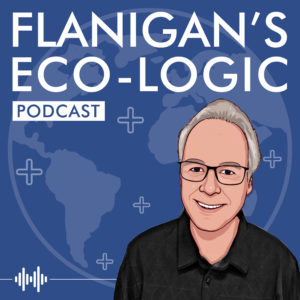
Use the links below to check out our recent podcasts. And you can always go to Spotify and type in “Ted Flanigan” to find our library of podcasts.
Recently Released:
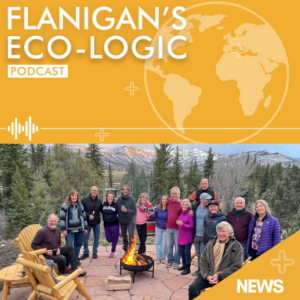
EcoNet News, Volume 25, Issue #4, celebrates Rocky Mountain Institute’s (RMI) impact! Ted shares his experience attending the RMI alumni event and reunion. The issue also highlights single-use battery disposal, renewables topping coal, offshore wind and fish farming, free public transportation in Luxembourg, parking lot solar, and Six Flags plan to install one of the largest solar carports in the country.

In this episode of Flanigan’s Eco-Logic, Ted speaks with April Bolduc, Founder and President of S Curve Strategies.
April is passionate about transportation electrification and has both been in the industry and driving electric vehicles for over 12 years. She has inspired thousands of drivers to do the same by working with states, counties, and utilities across the U.S. to develop and launch their electric vehicle (EV) infrastructure strategies.
At S Curve Strategies, April assists state and county agencies create fast charging corridors and strong EV policies. She helps utilities build strong EV teams, develop strategic plans and implement their EV customer experience efforts. Her clients rely on her for her innovative stakeholder engagement efforts that gain both regional consensus and results.
April and Ted discuss her studies at UC San Diego, graduating with a Bachelor of Arts in communication. Prior to forming S Curve Strategies in 2017, April led San Diego Gas & Electric’s EV customer experience. Her holistic approach to EV program development and grassroots campaigns has been the key to her success. Today, the region has one of the highest EV adoption rates of any city in the country.

In this episode of Flanigan’s Eco-Logic, Ted speaks with Steven Nadel, the Executive Director of the American Council for an Energy-Efficient Economy (ACEEE), a non-profit research organization.
Steven has worked in the energy efficiency field for over 40 years and has over 200 publications on energy-efficiency subjects. He has testified many times before the US Congress on energy efficiency subjects and was a major contributor to multiple new US energy laws including the 2022 Inflation Reduction Act.
He and Ted discuss studying Government at Wesleyan University, and receiving a Masters degree in Environmental Studies. Before ACEEE he worked for both the state of Massachusetts’ largest utility and largest environmental organization and also worked to bring energy efficiency to inner-city neighborhoods in Connecticut.
Steven joined ACEEE in 1989 and has served as Executive Director since 2001. He highlights his current research interests, including energy and climate change policy, strategies to decarbonize the buildings, transportation and industrial sectors, utility-sector energy efficiency programs and policies, and appliance and equipment efficiency standards.

In this episode of Flanigan’s Eco-Logic, Ted speaks with Cisco DeVries, CEO of OhmConnect, California’s leading residential clean energy program.
Cisco has over 20 years of experience in the energy sector. He served as an aide to the U.S. Secretary of Energy during the Clinton Administration, was chief of staff to the Mayor of Berkeley, and designed one of the most successful clean energy products, “Property Assessed Clean Energy” (PACE), which won the Scientific American World Changing Idea Award and is implemented in over 20 states. Cisco is now transforming Demand Response with OhmConnect, where he and his team are deploying their technologies to help reduce power demands during peak periods.
He and Ted discuss his upbringing just outside Yosemite National Park, studying at UC San Diego for his undergraduate degree, and then going on to Berkeley for his graduate program in Public Policy. Before OhmConnect, Cisco co-founded Renew Financial, which became one of the largest dedicated clean energy finance companies in the U.S. As CEO of Renew, he raised over $2 billion in private capital that financed energy efficiency and clean energy projects in nearly 100,000 homes.
Cisco explains what OhmConnect does, how their platform works, and what led him to now serve as CEO. He highlights their unique approach to using existing internet-connected thermostat and smart plugs, in conjunction with data from electric meters, to provide Demand Response benefits to the grid. Their business model is simple: customers get paid for lowering electric usage during high demand, and utilities can keep the power on without purchasing expensive peak power.

In this episode of Flanigan’s Eco-Logic, Ted speaks with John Perlin, Author of A Forest Journey: The Role of Trees in the Fate of Civilization.
He is also the author of three books on solar energy: A Golden Thread: 2500 Years of Solar Architecture and Technology; From Space to Earth: The Story of Solar Electricity; and Let It Shine: The 6000-Year Story of Solar Energy, as well as a visiting scholar in the department of physics at UC Santa Barbara.
He and Ted discuss him being a Los Angeles native, publishing the first edition of A Forest Journey: From Mesopotamia to North America” in 1986, and now, 34 years later, releasing an updated, third edition of the book via publisher, Patagonia.
John emphasizes the mitigation of climate change by renewing our symbiotic relationship with the trees that have sustained us. From construction to fuel to weaponry, John highlights that wood may be humanity’s most essential material. “Wood, in fact, is the unsung hero of the technological revolution that has brought us from stone-and-bone culture to our present age,” he writes.
